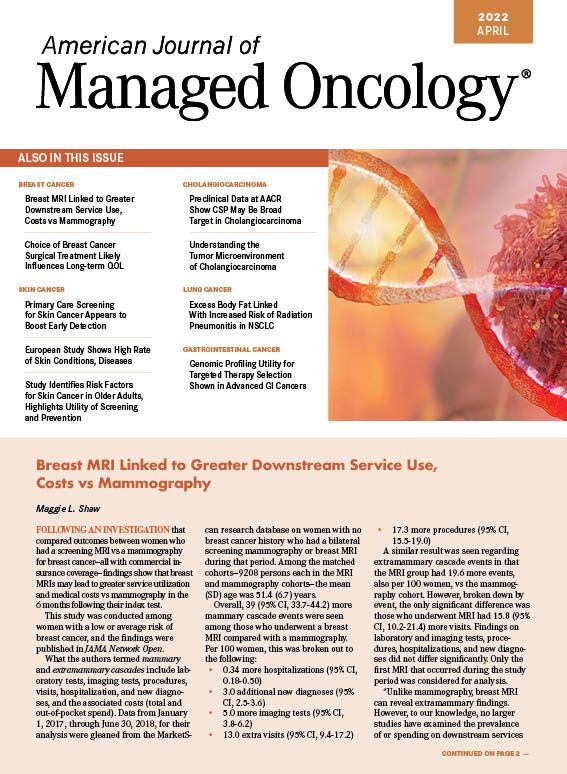- Center on Health Equity & Access
- Clinical
- Health Care Cost
- Health Care Delivery
- Insurance
- Policy
- Technology
- Value-Based Care
Study Identifies Risk Factors for Skin Cancer in Older Adults, Highlights Utility of Screening and Prevention
A recent study aimed to fill research gaps regarding skin cancer rates and risk factors in older adults.
Skin cancer is increasingly common, and certain risk factors such as skin type and sun exposure are already known to increase the odds of skin cancer development. But research is lacking when it comes to skin cancer risk in older populations, according to a recent study that aimed to provide insight into risk factors in a cohort aged between 70 and 93 years.
The study, published in BMC Geriatrics, explored associations between new skin cancers and history of previous skin cancer, sex, age, skin type, history of outdoor work, and socioeconomic status (SES). The potential clinical utility of regular total-body skin examination (TBSE) for earlier detection and prevention in these older patients was also assessed.
The retrospective cross-sectional study included data from 552 participants (346 women and 206 men) who were parents of children in the Northern Finland Birth Cohort 1966 (NFBC1966)
study. The NFBC1966 is an epidemiological and longitudinal research project that identified all pregnant women expected to deliver in 1966 in the Oulu and Lapland provinces in Finland, then followed them and their children.
In 2018, authors of the current study sent health questionnaires to 12,027 people who were part of the parents’ cohort in the NFBC1966. Of 5158 who answered, 1256 were invited to take part in a clinical examination, 684 agreed, and 552 were part of the final analysis population who received a TBSE. Data from registries and patient self-reporting were also used to determine risk factors for lifelong skin cancer versus first-time skin cancer in the cohort.
Based on the TBSE, 25.5% of patients had either skin cancer or a precursor to skin cancer. Men were more likely to have skin cancer or its precursors than women (34.5% vs. 20.2%, respectively), and patients diagnosed with skin cancer in the current study were more likely to have a history of it compared with those who had no current skin cancers (46.2% vs. 20.2%, respectively). Patients with past skin cancer diagnoses were more than twice as likely to have skin cancer later in life (odds ratio [OR], 2.56; 95% CI, 1.43-4.55).
Advanced age and SES were both associated with lifelong skin cancer ([OR, 1.05; 95% CI, 1.01-1.11] and [OR, 1.70; 95% CI, 1.00-2.95], respectively). Working outdoors was also associated with lifelong skin cancer in this cohort (OR, 1.92; 95% CI, 1.10-3.37). Fitzpatrick’s skin type was used to gauge associations between skin type and cancer occurrence, but no association was found in this cohort despite skin type being a well-known factor in skin cancer risk. This may be due to a lack of variability in skin types in the cohort, the authors noted.
In patients whose TBSE revealed a first skin cancer occurrence, more men than women had first-time skin cancer (27.8% vs. 15.4%). Working outdoors was also a risk factor (OR, 2.31; 95% CI, 1.16- 4.52) in the first skin cancer cohort.
Overall, the findings suggest that in older patients, previous skin cancer is a significant risk factor for new instances of skin cancer, as are male sex, advanced age, higher SES, and working outdoors. Men and participants who worked outdoors showed higher rates of initial cancer incidence at the time of the TSBE.
“In line with previous studies, we found that older age was associated with a greater risk of skin cancer. Even though best practices are yet to be determined for skin cancer screening, many studies have highlighted the importance of TBSE in older persons,” the authors wrote.
They also noted that skin cancer treatment costs are highest in late-onset disease, and patients diagnosed later have poorer survival rates.
“Physicians treating older persons are encouraged to perform a skin examination to detect skin cancers and their precursors,” the authors wrote.
“Previous history of skin cancer — which is easy to elicit from the patient — can act as a clue to the patient being at higher risk of new skin cancers. Because we found that skin cancer and precursors particularly affected men, we especially call for caution when treating older men,” they concluded.
Reference
Sinikumpu S, Jokelainen J, Keinänen-Kiukaanniemi S, Huilaja L. Skin cancers and their risk factors in older persons: a population-based study. BMC Geriatr. Published online April 1, 2022. doi:10.1186/s12877-022-02964-1

